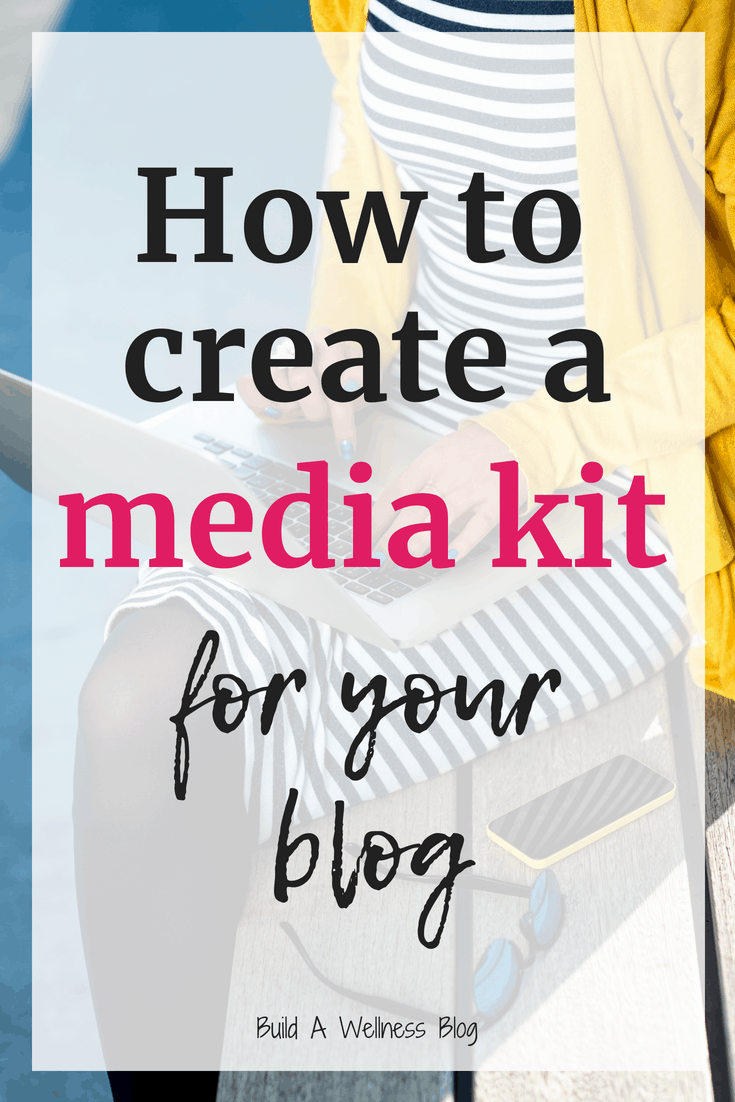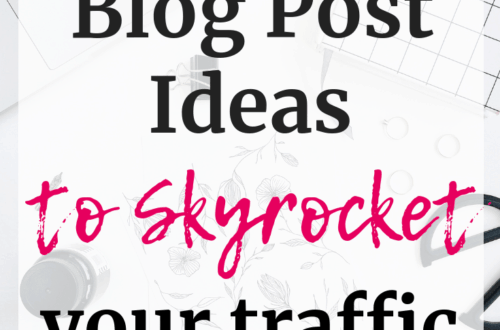
How to Create a Blogger Media Kit (+ Free Media Kit Template)!
Did you stumble across fellow bloggers in a Facebook group taking about a media kit – and now you’re thinking ‘what the heck is that’?! Or did a brand ask you for one, and now you’re scrambling to put one together? Not to fear, my friends. I’m going to break down everything you need to know about how to create a blogger media kit (or influencer media kit) – and even throw in a free template to make it super easy for you!
What is a Media Kit?
Let’s start with the basics. A media kit is simply a big picture overview of your blog’s niche, audience, and stats. Brands will sometimes ask for this when they’re evaluating if you’re a good fit for a partnership (like a sponsored post campaign). Occasionally affiliate partners may ask as well if the company runs their own affiliate program internally.
Your media kit is a place for you to showcase what makes your blog special. Don’t be worried if some of your stats are a bit lower than you’d hope for. If that’s the case, focus on your unique niche or audience, or on your blog’s recent growth.
Do Social Influencers Need a Media Kit Too?
If you’re a social media influencer without a blog, a media kit can be beneficial for you too. It can help you appear professional in your work, standing out from other “influencers” who are don’t necessarily care about results for the brand – but are rather just looking for free stuff. You’ll include very similar information – you just will describe your overall social brand rather than your blog. But the key parts like stats and audience remain the same.
What to Include in a Media Kit
Each blogger or influencer may have a slightly different set of information in their media kit, depending on how long they’ve been blogging and their current stats. For example, if you’ve been blogging and working with brands for a while, you might have a section in your media kit for “past partnerships”. But if you’re just starting, you may not have any of those to include (and that’s OK!).
Here are some things to consider including in your media kit:
1. Blog Logo / Name
I think this one is painfully obvious, but you’ll want to include these so people on the receiving end know what your site is! Use your blog’s logo in the media kit if you have one. If you don’t have a logo, a typed name is fine (though I’d recommend getting a logo done at some point).
If you’re a social influencer without a blog, think about whether you are primarily branded under a handle or under your real name – and use whichever one fits best.
2. Blog URL (Or Primary Social URL)
Include the blog URL somewhere in the media kit – whether it’s under the logo, in your blog description, or in you contact info. It may seem obvious to you based on the blog name/logo, but it’s wise to be extra cautious and include it.
If you’re a social influencer, you may want to consider including the URL for your primary social outlet.
3. About the Blog / Audience
What makes your blog or social channels special? What is your specific niche? Who is your ideal client and target market? What are the demographics (age, gender, etc) of your audience? These factors are ideal to include and will help a brand determine if your site is the right fit for a campaign/partnership.
4. About You
Is there something about you personally that adds extra incentive for brands to want to work with you? For example, are you a dietitian that can add credibility to nutrition messaging? Or are you a yoga instructor that has a large local following in addition to your online presence? These are great to weave into an “about ____” section.
You’ll also want to include your full name here (sounds simple but a lot of people forget!) and include your location. Sometimes brands are looking for people in certain demographic areas, so having your general location readily available is quite helpful.
5. Photo of You
If you have a blog that weaves in your personal life – meaning you as a person are frequently part of your brand — include a headshot or styled photo of you in the media kit. People connect with people.
6. Blog/Social Stats
You’ll want to include stats for your blog (if you have one) and all major social channels. This may include some or all of the following:
- Blog Unique Monthly Visitors
- Blog Monthly Page Views
- Email Subscribers
- Facebook Followers
- Twitter Followers
- Instagram Followers
- Pinterest Followers
- Pinterest Monthly Viewers
- YouTube Followers
- Growth statistics (X% increase in blog or social channel following over the last X months)
- Engagement statistics (X% engagement on Instagram; average blog comments per post)
7. Partnership Opportunities
How would you like to work with brands? What type of partnership opportunities do you feel comfortable working with? Sponsored content and social campaigns are the go-to for most people, but if you have other creative ideas outside of this – list them!
Here are just a few ideas for ways you might partner with brands:
- Sponsored blog post on your blog
- Social shares
- Twitter party host
- Recipe development for brand use
- Content creation for a brand’s blog/social channels
- Brand ambassador partnership
- Speaking on behalf of a brand
- Hosting a live event (dinner party, workout, etc)
- Participating in an expo event
- Creating an online challenge
8. Past Partnerships
If you’ve been blogging for a while and have already done a few sponsored campaigns, you might include a list of brands that you’ve worked with. I like to keep this section fluid, because of competitors and exclusivity.
For example, let’s say you worked with a fitness apparel brand a few years ago and that’s on your media kit. It was a one-off post that you enjoyed but you did not have any continued work with them. If you decide to pitch another fitness apparel brand later that’s a competitor, you probably want to avoid having that name/logo in your ‘past parternship’ sections.
9. Quotes, Testimonials, and Case Studies
If you have a quote or testimonial from a past brand you’ve worked with, that can be great to include in your media kit. It gives you credibility and helps brands see the value in working together.
Similarly, a case study can be a great option to include – though this is usually in addition to a media kit, not necessarily part of one. I don’t always include this, but if I’m pitching an ongoing partnership or I need an extra ‘umph’ to close a deal, a case study is helpful.
My case study PDF has a specific example of a brand I’ve partnered with, what we did together, and most importantly – the outcomes and results that the brand saw. You can also include a testimonial and/or contact info for that brand on here if they’ve agreed to it.
Should you Include Rates in Your Media Kit?
Ask 100 bloggers and you’ll probably find us split 50/50 down the middle on this. I prefer not to include my rates, and have a discussion with the brand based on what they would like in a partnership and their budget. Other bloggers prefer to include the rates up front to easily weed out the companies that are looking for free/cheap work. Go with what feels right for you!
I do recommend making a simple list of rates for your primary partnership ideas, so that if a brand asks for them, you’ll be able to quickly and easily produce that list. This is something that can (and should) be updated as your following grows and you gain experience.
How Often to Update Your Influencer / Blogger Media Kit
Since a media kit contains stats, it’s really a fluid document. What was on my media kit a year ago wouldn’t be reflective of my blog today. Ideally, you should update your media kit every 1-2 months to reflect the most current statistics.
This is why you’ll want to design a media kit that you can frequently edit – whether you’re feeling creative and want to design it yourself, or you want to use an editable template. What you don’t want to do is hire someone to design a media kit for you and only end up with a stagnant PDF file. If you hire someone to design one, make sure you have the original file template so that you can update it frequently.
Free Blogger Media Kit Template
I’ve created a free media kit template for you via Canva! It’s completely gratis for you to use this template and edit it accordingly.
But before you do edit anything, please follow these directions and DO NOT EDIT THE ORIGINAL FILE! –>
- Visit the link here to access the template.
- Click on “File” – you should see it up top on the status bar.
- IMPORTANT – Choose “Make a copy.” This will open a new window, and the new window will have a copy of the file saved to your Canva account. **This is the version you should edit. Please don’t edit the original template as then everyone else will see your changes. I’ve already had to fix this several times because of people ignoring directions, so please please make a copy before you start to edit! 🙂 **
Now that you have the copy to edit, it’s as simple as uploading your own logos/photos, changing colors to meet your brand needs, and adding in the appropriate text!
Other Media Kit Templates or Design:
Free Templates:
Canva itself also has a ton of free blogger media kit templates. Just browse through them and you’ll find hundreds that might suit your brand’s style and needs.
Paid Templates:
You can find paid templates on sites like Creative Market. Because they’re paid, there are likely less of them floating around the blog-o-sphere – meaning less chance of you having the same look as another blogger.
DIY Media Kit Design:
You can also obviously design your own media kit from scratch. Think about the overall aesthetic and look of your blog, and the colors you use on your site. You can use sites like Canva or PicMonkey, or programs like Photoshop, for creating a media kit.
Paid Media Kit Design:
If you want something truly unique – but you don’t have a creative bone in your body when it comes to graphic design – consider hiring someone to design your media kit. Again, just make sure you have an editable copy so you can update it with time.
I hope all this info is helpful as you prepare your influencer/blogger media kit! Now it’s time to start getting those brand partnerships and making that moolah! 🙂
Share with me: Have you created an influencer or blogger media kit? Has it been useful for you in reaching out to brands? What other questions do you have about media kits?





